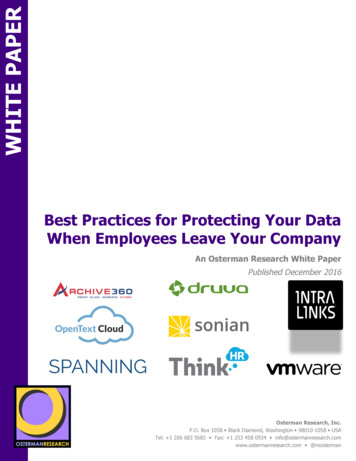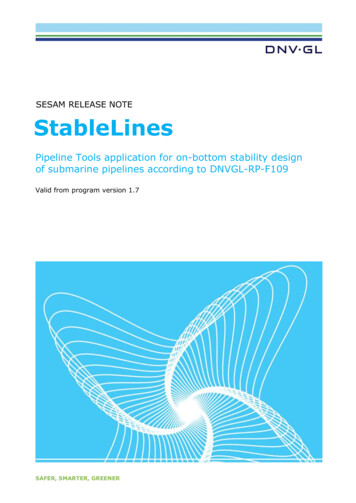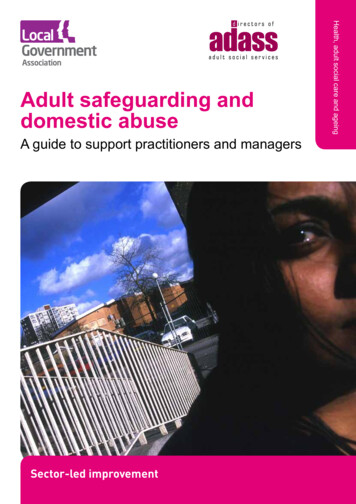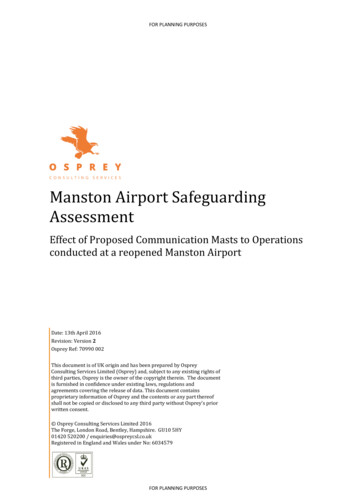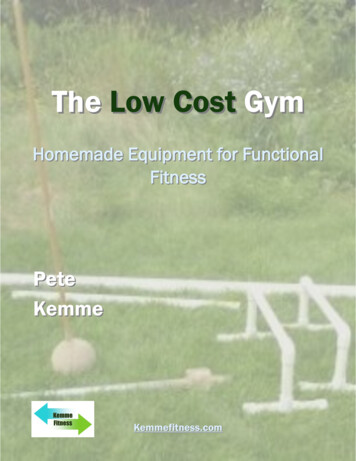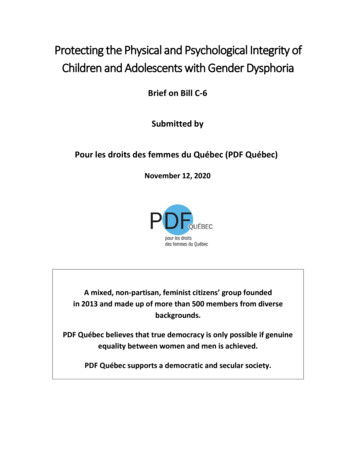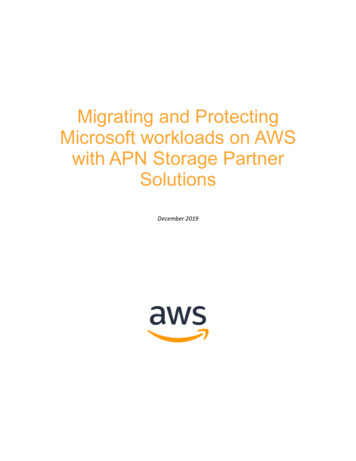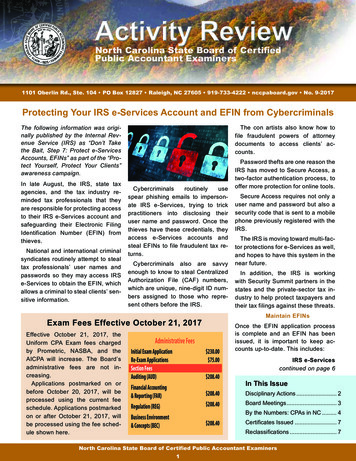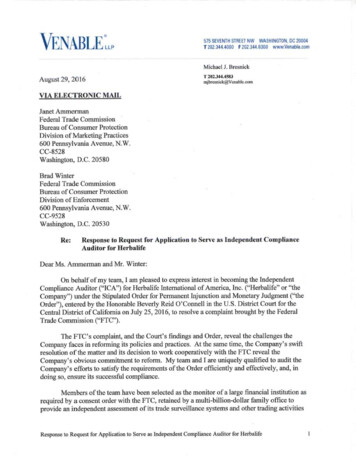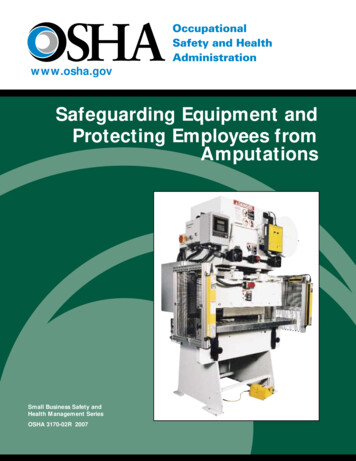
Transcription
www.osha.govSafeguarding Equipment andProtecting Employees fromAmputationsSmall Business Safety andHealth Management SeriesOSHA 3170-02R 2007
Employers are responsible for providing a safe andhealthful workplace for their employees. OSHA’srole is to assure the safety and health of America’semployees by setting and enforcing standards; providing training, outreach, and education; establishing partnerships; and encouraging continual improvement in workplace safety and health.This publication is in the public domain and may bereproduced, fully or partially, without permission.Source credit is requested, but not required.This information is available to sensory impairedindividuals upon request. Voice phone: (202) 6931999; teletypewriter (TTY) number: (877) 889-5627.Edwin G. Foulke, Jr.Assistant Secretary of Labor forOccupational Safety and Health
Safeguarding Equipmentand Protecting Employeesfrom AmputationsOccupational Safety and Health AdministrationU.S. Department of LaborOSHA 3170-02R2007
This OSHA publication is not a standard or regulation, and it creates no new legal obligations. Thepublication is advisory in nature, informational in content, and is intended to assist employers inproviding a safe and healthful workplace. The Occupational Safety and Health Act requires employersto comply with hazard-specific safety and health standards. In addition, pursuant to Section 5(a)(1),the General Duty Clause of the Act, employers must provide their employees with a workplace freefrom recognized hazards likely to cause death or serious physical harm. Employers can be cited forviolating the General Duty Clause if there is a recognized hazard and they do not take reasonablesteps to prevent or abate the hazard. However, failure to implement these recommendations is not,in itself, a violation of the General Duty Clause. Citations can only be based on standards, regulations, and the General Duty Clause.2Occupational Safety andHealth Administration
ContentsIntroduction5OSHA Standards5National Consensus Standards6Safeguarding Roll-Forming andRoll-Bending Machines33Other Controls for Roll-Forming andRoll-Bending MachinesRecognizing Amputation Hazards347Hazards of Shearing Machines357Safeguarding Shearing Machines36Hazardous Mechanical Motions7Other Controls for Shearing Machines36Hazardous Activities9Hazards of Food Slicers37Hazard Analysis9Safeguarding and Other Controls for9Hazards of Meat Grinders9Safeguarding and Other Controls forHazardous Mechanical ComponentsFood SlicersControlling Amputation HazardsSafeguarding Machinery3838Primary Safeguarding Methods10Guards10Hazards of Meat-Cutting Band SawsSafeguarding Devices13Safeguarding and Other Controls forSecondary Safeguarding Methods16Probe Detection and Safety Edge Devices16Hazards of Drill PressesAwareness Devices17Safeguarding and Other Controls forMeat Grinders39Meat-Cutting Band Saws4041Safeguarding Methods17Safe Work Procedures18Hazards of Milling MachinesComplementary Equipment18Safeguarding and Other Controls forAdministrative Issues19Inspection and Maintenance19Hazards of Grinding MachinesLockout/Tagout20Safeguarding and Other Controls forDrill Presses42Milling Machines2020Safeguarding Mechanical Power Presses22Other Controls for Mechanical Power PressServicing and Maintenance4546Hazards of SlittersHazards of Mechanical Power Presses4344Grinding MachinesSpecific Machine Hazards andSafeguarding Methods3946Safeguarding and Other Controls forSlitters47OSHA Assistance49References51Appendix A.Amputation Hazards Not Coveredin this Guide53Appendix B.Amputation Hazards Associatedwith Other Equipment and Activities54Appendix C.OSHA Regional Offices5523Training24Additional Requirements24Power Press Brakes25Hazards of Power Press Brakes25Safeguarding Power Press Brakes25Other Controls for Power Press Brakes26Hazards of Conveyors26Safeguarding Conveyors28Other Controls for Conveyors29Hazards of Printing Presses30Safeguarding Printing Presses31Other Controls for Printing Presses32Hazards of Roll-Forming andRoll-Bending EESFROMA M P U TAT I O N S3
Figure 22. Properly Guarded Foot ControlList of TablesTable1. Commonly Used Machine Guards12Table2. Types of Safeguarding Devices1319Figure 23. Part Revolution Mechanical PowerPress with a Two-Hand Control21Figure 24. Hand-Feeding Tools Used inList of FiguresConjunction with PullbacksFigure1. Rotating Motion7Figure2. Reciprocating Motion7Figure 25. Power Press Brake Bending Metal 25Figure3.7Figure 26. Two-Person Power Press BrakeFigure4. Cutting Action7Figure5. Punching Action8Figure 27.Transversing Motionon a Power Press23Operation with Pullbacks26Belt Conveyor27Figure6. Shearing Action8Figure 28. Screw ConveyorFigure7. Bending Action8Figure 29. Chain Driven Live Roller Conveyor 27Figure8. In-Running Nip Points8Figure9. Fixed Guard on a Power Press11Figure 10. Power Press with an AdjustableBarrier Guard11Figure 11. Self-Adjusting Guard on a27Figure 30. Slat Conveyor28Figure 31.31Roll-to-Roll Offset Printing PressFigure 32. Sheet-Fed Offset Printing Press31Figure 33. Roll-Forming Machine33Figure 34. In-Feed Area of a Roll-FormingRadial Saw11Figure 12. Interlocked Guard on a RollMachineFigure 35. Hydraulic Alligator ShearMake-up Machine113335Figure 36. Power Squaring Shear35Figure 13. Pullback Device on a Power Press 13Figure 37.37Figure 14. Restraint Device on a Power Press 16Figure 38. Stainless Steel Meat GrinderFigure 15. Presence-Sensing Device on aFigure 39. Stainless Steel Meat-CuttingPower Press16Figure 16. Two-Hand Control16Figure 17.16Power Press with a GateMeat SlicerBand Saw3840Figure 40. Drill Press with a TransparentDrill Shield41Bed Mill43Figure 18. Power Press with a Plunger Feed17Figure 41.Figure 19. Shuttle Ejection Mechanism18Figure 42. Horizontal Surface Grinder45Figure 20. Safety Tripod on a Rubber Mill18Figure 43. Paper Slitter47Figure 21.19Typical Hand-Feeding Tools4Occupational Safety andHealth Administration
IntroductionAmputations are among the most severe and disabling workplace injuries that often result in permanent disability. They are widespread and involvevarious activities and equipment. (The U.S. Bureauof Labor Statistics 2005 annual survey data indicated that there were 8,450 non-fatal amputation cases– involving days away from work – for all privateindustry. Approximately forty-four percent (44%) ofall workplace amputations occurred in the manufacturing sector and the rest occurred across theconstruction, agriculture, wholesale and retail trade,and service industries.) These injuries result fromthe use and care of machines such as saws, presses, conveyors, and bending, rolling or shapingmachines as well as from powered and non-powered hand tools, forklifts, doors, trash compactorsand during materials handling activities.Anyone responsible for the operation, servicing,and maintenance (also known as use and care) ofmachines (which, for purposes of this publicationincludes equipment) — employers, employees,safety professionals, and industrial hygienists—should read this publication. Primary safeguarding,as used in this publication, includes control methods that protect (e.g., prevent employee contactwith hazardous machine areas) employees frommachine hazards through effective machine guarding techniques. In addition, a hazardous energycontrol (lockout/tagout) program needs to complement machine safeguarding methods in order toprotect employees during potentially hazardousservicing and maintenance work activities.This guide can help you, the small businessemployer, identify and manage common amputation hazards associated with the operation and careof machines. The first two sections of the document,Recognizing Amputation Hazards and ControllingAmputation Hazards, look at sources of amputations and how to safeguard machinery and controlemployee exposure to hazardous energy (lockout/tagout) during machine servicing and maintenanceactivities. The section on Specific MachineryHazards and Safeguarding Methods identifies thehazards and various control methods for machineryassociated with workplace amputations, such as:mechanical power presses, press brakes, conveyors, printing presses, roll-forming and roll-bendingmachines, shears, food slicers, meat grinders, meatcutting band saws, drill presses, milling machines,grinding machines, and slitting machines.The information in this booklet does not specifically address amputation hazards on all types ofSAFEGUARDINGEQUIPMENTANDmachinery in general industry, construction, maritime and agricultural operations; however, manyof the described safeguarding techniques may beused to prevent other amputation injuries. Additionally, while this manual concentrates attentionon concepts and techniques for safeguardingmechanical motion, machines obviously present avariety of other types of energy hazards that cannotbe ignored. For example, pressure system failurecould cause fires and explosions. Machine electrical sources also pose electrical hazards that areaddressed by other OSHA standards, such as theelectrical standards contained in Subpart S. Fulldiscussion of these matters is beyond the scope ofthis publication. For compliance assistance purposes, references and the appendices are provided onapplicable OSHA standards, additional informationsources, and ways you may obtain OSHA assistance.OSHA StandardsAlthough this guide recommends ways to safeguardand lockout/tagout energy sources associated withmachinery hazards, there are legal requirements inOSHA standards that you need to know about andcomply with. The following OSHA standards are afew of the regulations that protect employees fromamputation hazards.Machinery and Machine Guarding:29 CFR Part 1910, Subpart O 1910.211 – Definitions 1910.212 – General requirements for allmachines 1910.213 – Woodworking machinery requirements 1910.215 – Abrasive wheel machinery 1910.216 – Mills and calenders in the rubberand plastics industries 1910.217 – Mechanical power presses 1910.218 – Forging machines 1910.219 – Mechanical power-transmissionapparatusControl of Hazardous Energy (Lockout/Tagout):29 CFR 1910.147Hand and Power Tools:29 CFR Part 1926, Subpart I 1926.300 – General requirements 1926.303 – Abrasive wheels and tools 1926.307 – Mechanical power-transmissionapparatusConveyors:29 CFR 1926.555PROTECTINGEMPLOYEESFROMA M P U TAT I O N S5
Concrete and Masonry Construction29 CFR Part 1926, Subpart Q 1926.702 – Requirements for equipment andtoolsConsult these standards directly to ensure fullcompliance with the provisions as this publicationis not a substitute for the standards. States withOSHA-approved plans have at least equivalentstandards. For detailed information about machineguarding and lockout/tagout, see the followingresources: Machine Guarding Safety and Health TopicsPage ml) Machine Guarding eTool ndex.html) OSHA Publication 3067, Concepts and Techniquesof Machine Safeguarding (http://www.osha.gov/Publications/Mach Safeguarding/toc.html) OSHA Directive STD 01-05-019 [STD 1-7.3],Control of Hazardous Energy (Lockout/Tagout)—Inspection Procedures and Interpretive Guidance Control of Hazardous Energy (Lockout/Tagout)Safety and Health Topics Page ndex.html) OSHA’s Lockout Tagout Interactive TrainingProgram tm) OSHA Publication 3120, Control of HazardousEnergy (Lockout/Tagout)OSHA standards, directives, publications,and other resources are available online atwww.osha.gov.National Consensus StandardsOSHA recognizes the valuable contributions ofnational consensus standards and these voluntarystandards may be used as guidance and recognitionof industry accepted practices. For example, theAmerican National Standards Institute (ANSI) publishes numerous voluntary national consensus standards on the safe care and use of specific machinery.These consensus standards provide you with usefulguidance on how to protect your em-ployees frommachine amputation hazards and the controlmethods described may assist you in complyingwith OSHA performance-based standards.Furthermore, OSHA encourages employers toabide by the more current industry consensus standards since those standards are more likely to beabreast of the state of the art than an applicableOSHA standard may be. However, when a consensus standard addresses safety considerations, OSHAmay determine that the safety practices describedby that consensus standard are less protective thanthe requirement(s) set forth by the pertinent OSHAregulations. OSHA enforcement policy regardingthe use of consensus standards is that a violationof an OSHA standard may be deemed de minimisin nature if the employer complies with a consensus standard (that is not incorporated by reference)rather than the OSHA standard in effect and if theemployer’s action clearly provides equal or greateremployee protection. (Such de minimis violationsrequire no corrective action and result in no penalty.)For example, the OSHA point-of-operationguarding provisions, contained in paragraph1910.212(a)(3), require the guarding device to bein conformance with any appropriate standardsthereof, or in the absence of applicable specificstandards, shall be so designed and constructed asto prevent the operator from having any part of hisbody in the danger zone during the operating cycle.The terms applicable standards or appropriate standards, as used in the context of 29 CFR 1910.212,are references to those private consensus standards that were adopted (source standards) orincorporated by reference in the OSHA standards.In some instances, a specific national consensusstandard (that is not incorporated by reference or asource standard), such as an ANSI standard for aparticular machine, may be used for guidance purposes to assist employers in preventing an operator from having any body part in the machine danger zone during the operating cycle. Also, OSHAmay, in appropriate cases, use these consensusstandards as evidence that machine hazards are recognized and that there are feasible means of correcting the hazard. On the other hand, some national consensus standards may sanction practices thatprovide less employee protection than that providedby compliance with the relevant OSHA provisions.In these cases, compliance with the specific consensus standard provision would not constitute compliance with the relevant OSHA requirement.Under the Fair Labor Standards Act (FLSA), theSecretary of Labor has designated certain nonfarm jobs as particularly hazardous for employees younger than 18. Generally, these employees are prohibited from operating: Band saws Circular saws Guillotineshears Punching and shearing machines Meatpacking or meat-processing machines Certain power-driven machines: Paper productsmachines, Woodworking machines, Metalforming machines, and Meat slicers.6Occupational Safety andHealth Administration
Recognizing AmputationHazardsTo prevent employee amputations, you and youremployees must first be able to recognize the contributing factors, such as the hazardous energy associated with your machinery and the specific employeeactivities performed with the mechanical operation.Understanding the mechanical components ofmachinery, the hazardous mechanical motion thatoccurs at or near these components and specificemployee activities performed in conjunction withmachinery operation will help employees avoid injury.Reciprocating Motion (Figure 2) is back-and-forthor up-and-down motion that may strike or entrapan employee between a moving part and a fixedobject.Figure 2 Reciprocating MotionTableBed (stationary)Hazardous Mechanical ComponentsThree types of mechanical components presentamputation hazards:Point of Operation is the area of the machinewhere the machine performs work – i.e., mechanical actions that occur at the point of operation,such as cutting, shaping, boring, and forming.Transversing Motion (Figure 3) is motion in astraight, continuous line that may strike or catchan employee in a pinch or shear point created bythe moving part and a fixed object.Figure 3 Transversing MotionPower-Transmission Apparatus is all componentsof the mechanical system that transmit energy,such as flywheels, pulleys, belts, chains, couplings,connecting rods, spindles, cams, and gears.Other Moving Parts are the parts of the machinethat move while the machine is operating, suchas reciprocating, rotating, and transverse moving parts as well as lead mechanisms and auxiliary parts of the machine.Hazardous Mechanical MotionsA wide variety of mechanical motion is potentiallyhazardous. Here are the basic types of hazardousmechanical motions:Rotating Motion (Figure 1) is circular motion suchas action generated by rotating collars, couplings,cams, clutches, flywheels, shaft ends, and spindles that may grip clothing or otherwise force abody part into a dangerous location. Even smoothsurfaced rotating machine parts can be hazardous.Projections such as screws or burrs on the rotating part increase the hazard potential.Cutting Action (Figure 4) is the action that cutsmaterial and the associated machine motion maybe rotating, reciprocating, or transverse.Figure 4 Cutting ActionFigure 1 Rotating ROMA M P U TAT I O N S7
Punching Action (Figure 5) begins when powercauses the machine to hit a slide (ram) to stampor blank metal or other material. The hazardoccurs at the point of operation where theemployee typically inserts, holds, or withdrawsthe stock by hand.Bending Action (Figure 7) is power applied to aslide to draw or stamp metal or other materials ina bending motion. The hazard occurs at the pointof operation where the employee typically inserts,holds, or withdraws the stock by hand.Figure 7 Bending ActionFigure 5 Punching ActionPunchStockDieShearing Action (Figure 6) involves applyingpower to a slide or knife in order to trim or shearmetal or other materials. The hazard occurs at thepoint of operation where the employee typicallyinserts, holds, or withdraws the stock by hand.Figure 6 Shearing ActionIn-Running Nip Points (Figure 8), also known as“pinch points,” develop when two parts movetogether and at least one moves in rotary or circular motion. In-running nip points occur whenevermachine parts move toward each other or whenone part moves past a stationary object. Typicalnip points include gears, rollers, belt drives, andpulleys.Figure 8 In-Running Nip PointsNip PointNip PointBladeStockNipPointNip PointNipPointTypical Nip Point8Occupational Safety andHealth Administration
Hazardous ActivitiesEmployees operating and caring for machineryperform various activities that present potentialamputation hazards.Machine set-up/threading/preparation,*Machine inspection,*Normal production operations,Clearing jams,*Machine adjustments,*Cleaning of machine,*Lubricating of machine parts,* andScheduled and unscheduled maintenance.*Controlling AmputationHazardsSafeguarding is essential for protecting employeesfrom needless and preventable injury. A good ruleto remember is:Any machine part, function, or process that maycause injury must be safeguarded.* These activities are servicing and/or maintenance activities.Hazard AnalysisYou can help prevent workplace amputations bylooking at your workplace operations and identifying the hazards associated with the use and care ofthe machine. A hazard analysis is a technique thatfocuses on the relationship between the employee,the task, the tools, and the environment. Whenevaluating work activities for potential amputationhazards, you need to consider the entire machineoperation production process, the machine modesof operation, individual activities associated withthe operation, servicing and maintenance of themachine, and the potential for injury to employees.The results from the analysis may then be usedas a basis to design machine safeguarding and anoverall energy control (lockout/tagout) program.This is likely to result in fewer employee amputations; safer, more effective work methods; reducedworkers’ compensation costs; and increased employee productivity and morale.In this booklet, the term primary safeguardingmethods refers to machine guarding techniquesthat are intended to prevent or greatly reduce thechance that an employee will have an amputationinjury. Refer to the OSHA general industry (e.g.,Subpart O) and construction (e.g., Subparts I andN) standards for specific guarding requirements.Many of these standards address preventive methods (such as using barrier guards or two-hand tripping devices) as primary control measures; whileother OSHA standards allow guarding techniques(such as a self-adjustable table saw guard) thatreduce the likelihood of injury. Other less protectivesafeguarding methods (such as safe work methods)that do not satisfactorily protect employees fromthe machine hazard areas are considered secondary control methods.Machine safeguarding must be supplementedby an effective energy control (lockout/tagout)program that ensures that employees are protectedfrom hazardous energy sources during machineservicing and maintenance work activities.Lockout/tagout plays an essential role in the prevention and control of workplace amputations. Interms of controlling amputation hazards, employees are protected from hazardous machine workactivities either by: 1) effective machine safeguarding, or 2) lockout/tagout where safeguards are rendered ineffective or do not protect employees fromhazardous energy during servicing and maintenance operations.Additionally, there are some servicing activities,such as lubricating, cleaning, releasing jams andmaking machine adjustments that are minor innature and are performed during normal production operations. It is not necessary to lockout/tagout a machine if the activity is routine, repetitiveand integral to the production operation providedthat you use an alternative control method thataffords effective protection from the machine’shazardous energy sources.Safeguarding MachineryThe employer is responsible for safeguardingmachines and should consider this need when purchasing machinery. Almost all new machinery isSAFEGUARDINGEQUIPMENTANDPROTECTINGEMPLOYEESFROMA M P U TAT I O N S9
available with safeguards installed by the manufacturer, but used equipment may not be.If machinery has no safeguards, you may beable to purchase safeguards from the originalmachine manufacturer or from an after-marketmanufacturer. You can also build and install thesafeguards in-house. Safeguarding equipmentshould be designed and installed only by technically qualified professionals. If possible, the originalequipment manufacturer should review the safeguard design to ensure that it will protect employees without interfering with the operation of themachine or creating additional hazards.Regardless of the source of safeguards, theguards and devices used need to be compatiblewith a machine’s operation and designed to ensuresafe operator use. The type of operation, size, andshape of stock, method of feeding, physical layoutof the work area, and production requirements allaffect the selection of safeguards. Also, safeguardsshould be designed with the machine operator inmind as a guarding method that interferes with theoperation of the machine may cause employees tooverride them. To ensure effective and safe operatoruse, guards and devices should suit the operation.The Performance Criteria for Safeguarding[ANSI B11.19-2003] national consensus standardprovides valuable guidance as the standardaddresses the design, construction, installation,operation and maintenance of the safeguardingused to protect employees from machine hazards.The following safeguarding method descriptionsare, in part, structured like and, in many ways aresimilar to this national consensus standard.The Performance Criteria for Safeguarding [ANSIB11.19-2003] defines safeguarding as the protection of personnel from hazards by the use ofguards, safeguarding devices awareness devices,safeguarding methods, or safe work procedures.The following ANSI B11.19 definitions describethe various types of safeguarding:Guard: A barrier that prevents exposure to anidentified hazard.Safeguarding device: A device that detects orprevents inadvertent access to a hazard.NOTE: The 1990 ANSI B11.19 term Safeguardingdevice was modified to Safeguarding (Protective)Device in the revised 2003 ANSI standard and thenew term includes a detection component. Devices that detect, but do not prevent employeeexposure to machine hazards are not consideredby OSHA to be primary safeguarding methods.Awareness device: A barrier, signal or sign thatwarns individuals of an impending, approachingor present hazard.Safeguarding method: Safeguarding implemented to protect individuals from hazards by thephysical arrangement of distance, holding, openings, or positioning of the machine or machineproduction system to ensure that the operatorcannot reach the hazard.Safe work procedures: Formal written instructions developed by the user which describe howa task is to be performed.Primary Safeguarding MethodsTwo primary methods are used to safeguardmachines: guards and some types of safeguardingdevices. Guards provide physical barriers that prevent access to danger areas. Safeguarding deviceseither prevent or detect operator contact with thepoint of operation or stop potentially hazardousmachine motion if any part of an individual’s bodyis within the hazardous portion of the machine.Both types of safeguards need to be properlydesigned, constructed, installed, used and maintained in good operating condition to ensureemployee protection.Criteria for Machine Safeguarding Prevents employee contact with the hazardarea during machine operation. Avoids creating additional hazards. Is secure, tamper-resistant, and durable. Avoids interfering with normal operation ofthe machine. Allows for safe lubrication and maintenance.GuardsGuards usually are preferable to other controlmethods because they are physical barriers thatenclose dangerous machine parts and preventemployee contact with them. To be effective,guards must be strong and fastened by any securemethod that prevents the guard from being inadvertently dislodged or removed. Guards typicallyare designed with screws, bolts and lock fastenersand usually a tool is necessary to unfasten and1 0Occupational Safety andHealth Administration
remove them. Generally, guards are designed notto obstruct the operator’s view or to preventemployees from doing a job.In some cases, guarding may be used as analternative to lockout/tagout because employeescan safely service or maintain machines with aguard in place. For example, polycarbonate andwire-mesh guards provide greater visibility and canbe used to allow maintenance employees to safelyobserve system components. In other instances,employees may safely access machine areas, without locking or tagging out, to perform maintenancework (such as machine cleaning or oiling tasks)because the hazardous machine componentsremain effectively guarded.Guards must not create additional hazards suchas pinch points or shear points between guardsand other machine parts. Guard openings shouldbe small enough to prevent employees fromaccessing danger areas. (See Table 1 and Figures9 through 12 for commonly used machine guards.)Figure 11 Self-Adjusting Guard on a Radial SawHandleAntiKickbackDeviceGuardBladeFigure 12 Interlocked Guard on a Roll Make-up MachineFigure 9 Fixed Guard on a Power nt InsertFigure 10 Power Press with an Adjustable Barrier SFROMA M P U TAT I O N S11
Table 1. Commonly Used Machine GuardsTypes of Machine GuardsTypeMethod ofSafeguardingAdvantagesLimitationsFixedBarrier that allows forstock feeding but does notpermit operator to reachthe danger area. Can be constructed to suitmany applications. Permanently enclosesthe point of operation orhazard area. Provides protectionagainst machine repeat. Allows simple, in-plantconstruction, with minimal maintenance. Sometimes not practicalfor changing productionruns involving differentsize stock or feedingmethods. Machine adjustment andrepair often require guardremoval. Other means of protectingmaintenance personneloften required(lockout/tagout).AdjustableBarrier that adjusts fora variety of productionoperations. Can be constructed tosuit many applications. Can be adjusted to admitvarying stock sizes. May require frequentmaintenance oradjustment. Operator may makeguard ineffective.SelfAdjustingBarrier that movesaccording to the size of thestock entering point ofoperation. Guard is in placewhen machine is at restand pushes away whenstock enters the point ofoperation. Off-the-shelf guards areoften commercially available. Does not providemaximum protection. May require frequentmaintenance andadjustment.InterlockingBarrierGuardsShuts off or disengagespower and preventsmachine start-up whenguard is open. Shouldallow for inching ofmachine. Allows access for someminor servicing work, inaccordance with the lockout/tagout exception,without time-consumingremoval of fixed guards. May require periodicmaintenance or adjustment. Movable sections cannotbe used for manual feeding. Some designs may beeasy to defeat. Interlock control circuitrymay not be used for allmaintenance and servicing work.1 2Occupational Safety andHealth Administration
Safeguarding DevicesSafeguarding devices are controls or attachmentsthat, when properly designed, applied and used,usually prevent inadvertent access by employees tohazardous machine areas by: Preventing hazardous machine component operation if your hand or body part is inadvertentlyplaced in the danger area;Restraining or withdrawing your hands f
the General Duty Clause of the Act, employers must provide their employees with a workplace free from recognized hazards likely to cause death or serious physical harm. Employers can be cited for violating the General Duty Clause if there is a recognized hazard and they do
